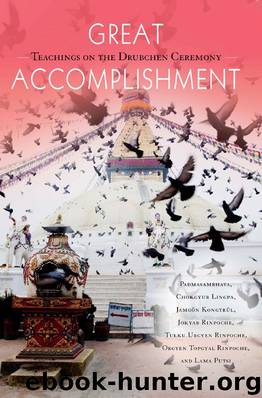Great Accomplishment by Tulku Urgyen Rinpoche & Orgyen Topgyal Rinpoche & Lama Putsi

Author:Tulku Urgyen Rinpoche & Orgyen Topgyal Rinpoche & Lama Putsi [Urgyen Rinpoche, Tulku]
Language: eng
Format: epub
Publisher: Rangjung Yeshe Publications
Published: 2013-11-29T13:00:00+00:00
Samantabhadra and Consort
Dissolving Duality
CONFERRING EMPOWERMENT
If you were to zoom in on the peaceful or wrathful deities, you would see that in each of their heart centers is a wisdom being (jnana sattva) who looks identical to it, in a simple unadorned form without ornaments, implements, or symbolic emblems. If you were then to look closely at these wisdom beings, you would discover that within their heart centers is the same symbolic emblem that the deity itself holds, and inside this emblem is the radiant seed syllable from which the deity was originally generated, surrounded by its shining mantra. The wisdom being within each deity is the same color as the deity itself, as is the seed syllable. The specific mantras that encircle the seed syllables can be found elsewhere. The seed syllables and the mantras shine into all directions and invoke the forms of the buddhas of the ten directions to approach.
The buddhas of the five families in union with their consorts appear at the crown of our heads. From the union of each pair appears a stream of nectar that purifies the tendencies for one of the five disturbing emotions.
You should now assume the confidence that the five male buddhas are the purity of the five aggregates (skandhas). The first one, Buddha Vairochana, is the natural purity of the aggregate of forms. Ratnasambhava is the natural purity of the aggregate of sensations. Amitabha is the natural purity of the aggregate of perceptions, and Amoghasiddhi is the natural purity of the aggregate of formations. Lastly, Akshobhya is the natural purity of the aggregate of cognition or consciousness.
But it is not only we who bear a crown, for each of the one hundred deities is similarly crowned with five buddhas; these are not in union, however, but solitary. The buddha related to whichever family the deity belongs is in the center on the top of the head, with the other four on the surrounding sides. For example, for male deities belonging to the lotus family, Amitabha will be in the center with the four other male buddhas surrounding him; the female deities of the lotus family are crowned with Amitabha’s consort, Pandaravasini, and the other four female buddhas.
Imagining each and every deity crowned with the five buddhas, we recite the mantra related to each of the five family buddhas while forming the corresponding mudra. Each mantra relates to one of the five wisdoms:
OM MAHA SHUNYATA JNANA VAJRA SVABHAVA ATMA KOH HANG
OM MAHA ADARSHA JNANA VAJRA SVABHAVA ATMA KOH HANG
OM MAHA SAMATA JNANA VAJRA SVABHAVA ATMA KOH HANG
OM MAHA PRATYA BEKSHANE JNANA VAJRA SVABHAVA ATMA KOH HANG
OM MAHA KRITYA ANUSH THANA JNANA VAJRA SVABHAVA ATMA KOH HANG
Download
This site does not store any files on its server. We only index and link to content provided by other sites. Please contact the content providers to delete copyright contents if any and email us, we'll remove relevant links or contents immediately.
The Way of Zen by Alan W. Watts(5798)
Ego Is the Enemy by Ryan Holiday(3991)
The Art of Happiness by The Dalai Lama(3382)
The Book of Joy by Dalai Lama(3217)
Why Buddhism is True by Robert Wright(2826)
Shift into Freedom by Loch Kelly(2692)
Spark Joy by Marie Kondo(2674)
Happiness by Matthieu Ricard(2522)
A Monk's Guide to a Clean House and Mind by Shoukei Matsumoto(2404)
The Lost Art of Good Conversation by Sakyong Mipham(2125)
The Meaning of the Library by unknow(2067)
The Third Eye by T. Lobsang Rampa(1883)
The Unfettered Mind: Writings from a Zen Master to a Master Swordsman by Takuan Soho(1859)
Anthology by T J(1752)
Red Shambhala by Andrei Znamenski(1747)
The Diamond Cutter by Geshe Michael Roach(1671)
Thoughts Without A Thinker: Psychotherapy from a Buddhist Perspective by Epstein Mark(1591)
Advice Not Given by Mark Epstein(1521)
Twilight of Idols and Anti-Christ by Friedrich Nietzsche(1491)
